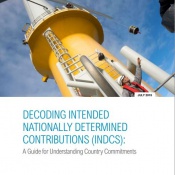A Guide To Decoding Intended Nationally Determined Contributions
Throughout this year, countries are publishing their climate action plans – or “Intended Nationally-Determined Contributions” to the climate effort, and they’re all to be brought under the umbrella of a global agreement at year-end climate talks in Paris. But what makes a good INDC, and how can we evaluate them? The World Resources Institute is offering help with a new guide explaining the INDC and outlining six key questions to ask when weighing their effectiveness.

This article is an excerpt from WRI’s Decoding Intended Nationally Determined Contributions framework. Click here to view the guide.
17 August 2015 | Intended Nationally Determined Contributions, or INDCs, are public outlines of what individual countries plan to do to deal with a changing climate, starting in 2020 under a new international climate agreement. This agreement is expected to be adopted in December in Paris at the end of the U.N. Framework Convention on Climate Change (UNFCCC) Conference of the Parties (COP21). INDCs serve as critical inputs for COP21, where countries will determine whether the world achieves an ambitious agreement and is put on an accelerated path towards a low-carbon, climate-resilient future.
The climate plans lay out a country’s vision for climate action well into the next decade, and this vision will drive policy and investment at the local, national and global level for years to come. These political commitments to address climate change can help governments build a new climate economy where emissions reductions, sustainable economic development and poverty reduction go hand in hand. As these policies and investments gain momentum, they can spur more ambitious commitments at the international level.
Markings of a Strong INDC
A solid INDC is both fair and ambitious. It supports the objective of the UNFCCC– meaning that it lines up with what science tells us is necessary to avoid the worst impacts of climate change. Moreover, it is linked to national priorities and it is feasible to implement. Finally, it is reported transparently, so that everyone can understand what the country intends to achieve and can monitor progress towards that achievement.
6 KEY QUESTIONS TO ASK IN EVALUATING AN INDC
- Does the INDC contain a clear statement of intent?
- Is the INDC in line with science?
- Is the INDC fair and ambitious?
- Has the INDC been designed following a strong process?
- Is the INDC feasible to implement?
- Is the INDC transparent?
Follow this link for more detail on each evaluation question and to view the WRI guidance in full.
Please see our Reprint Guidelines for details on republishing our articles.


